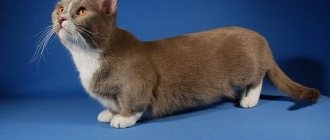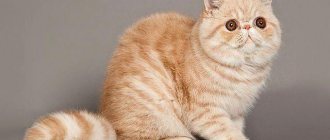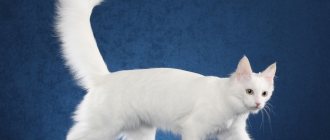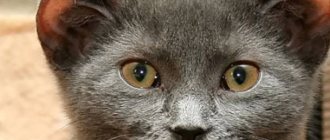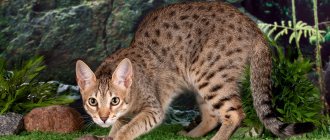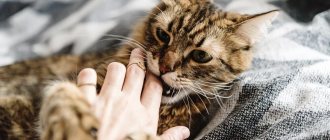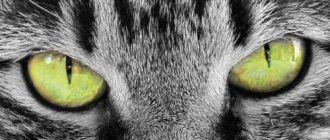Origin
The first known image of a cat appeared in a collection of funny cat photos on the website The Chive, published on June 30, 2018.
On July 2, 2020, the Instagram account livewithflip published a fake screenshot of a correspondence in which the tenant sends a photo of the cat to the apartment owner. In the invented dialogue, the cat in the photograph seems very polite to the homeowner, and he allows him to live in the house.
Homeowner: “The conditions clearly state: no pets in the apartment. Sorry". Tenant: *photo* Homeowner: “Okay, I’ll make an exception since he seems very polite.”
The Instagram post received more than 22 thousand likes. In the following days, a screenshot of the conversation was reposted multiple times on Twitter and Reddit, including popular posts on July 3 in the communities r/GoodFakeTexts (7.7 thousand upvotes), r/BadFakeTexts (4.5 thousand upvotes) and r/memeeconomy (15.2 thousands of upvotes).
On July 3, r/animemes user Myom_Everwind used a screenshot of the conversation as the basis for a meme, replacing the image of the cat with Felix Argyle, a character from the anime Re:Zero. The meme received more than 300 upvotes.
“The conditions clearly state: no pets in the apartment. Sorry". *photo* “Okay, I’ll make an exception since he seems very polite.”
Posts using the template appeared in other communities, including r/dankmemes, r/kilian, as well as on Instagram and other social networks.
“The conditions clearly state: no pets in the apartment. Sorry". *photo* “Okay, I’ll make an exception since he looks very polite” – skyguy_memes101
On July 10, redditor HOTLILPAPI posted a photoshopped image of a cat in the r/me_irl community. The animal's mouth and nose were greatly enlarged, and the cat's eyes were moved to his ears. The post received more than 24.5 thousand upvotes.
The resulting image gained great popularity in Russian meme-publics. For example, on July 12, FTP published the following cat meme.
On July 9, an account @khan_amon_ra appeared on Instagram, belonging to the cat’s owner. As it turned out, the cat’s name is Ollie, and his “polite” photo was created in a graphics editor.
Rare and non-standard cat breeds
Less common cats with large ears include:
- poodle cat;
- Havana;
- toyger
Poodle cat
These curly cats with large ears appeared quite recently and have not yet become popular. Their curly coat makes them resemble a poodle. Representatives of the breed are not only straight-eared, but also lop-eared. These unusual cats have a friendly and easy-going disposition.
Long-eared poodle cats easily adapt to any conditions and tolerate loneliness well.
Havana
The breed, called Havana Brown, was developed in the UK by crossing a Siamese and a domestic black cat. Despite the fact that Havana was registered in the middle of the last century, it was not widely used.
These elegant short-haired cats with large ears and a long muzzle are easily recognized by their unusual ellipse-shaped head and shiny dark brown coat.
Toyger
These long-eared cats with a long muzzle were bred in America in 1993. Outwardly, they resemble miniature tigers. The toyger's long body is covered with short, spotted fur. And a “domestic tiger” weighs only 7-9 kg.
Spotted cats with large ears are endowed with a calm and friendly disposition. Toygers quickly become attached to their owners and easily adapt to apartment living.
Meaning
Polite Cat is a viral photograph of a cat with a “polite” facial expression, which has become the basis for various memes. In the West, the most popular format is that using a screenshot of fake correspondence: the photo of the Polite Cat is replaced with images of other characters.
In Russia, an edited version of the photograph in which the cat's eyes are placed on his ears has become very famous. Memes with a photoshopped photo of a cat do not have a single concept and usually play off the funny and slightly scary appearance of the resulting animal. Relatives are sometimes added to a polite cat by editing other photographs of cats in a manner similar to the original.
American Curl - a cat with ears curled back
The stylish, flirtatiously curved back ears of American Curls are hard to the touch, like horns. The special shape of the ears gives the face of these cats a surprised expression, as well as sophistication and uniqueness. This breed of cats arose in the 80s of the last century, as a result of a genetic mutation. Breeders picked up the baton and bred American Curls of various colors and different lengths of hair.
In addition to their unique appearance, American Curls have a wonderful character. Loyal, gentle, cheerful and inquisitive - all this is about representatives of the breed. Moreover, cats keep all these traits throughout their lives, that is, regardless of age. Overall, the American Curl will make a wonderful companion! You can find out more about this breed of cats (detailed description, character, care, diseases, video) here:.
Mr. Cat explains: Why does a cat need big ears?
If you objectively evaluate the proportions of a cat's body, the ears will seem disproportionately large. Even the British, who have small, neat ears, have ears that are much larger than human standards. And the point here is not that it is primarily an instrument of hearing.
Hearing is excellent in absolutely all breeds and species. This is due to the unique structure of the auricle. In addition, the ears are a kind of locators. Each pet's ear is equipped with thirty-two muscles, which provide high mobility and allow the animal to “prick up” its ears to any sound source. Ears also serve as a kind of means of communication. An angry or frightened animal will press them to its head and hiss, indicating its readiness to attack or defend. A calm pet's ears are relaxed and extended. But at the slightest noise they are the first to tense up, demonstrating the cat’s readiness to run towards the source of the sound or escape from danger.
The range of frequencies that felines pick up is striking in its breadth. A cat can hear the rustle of a mouse in a hole.
A cat's hearing is tuned primarily to high frequencies. Thus, a person picks up sounds in the range from 16 to 20 kilohertz, and a cat from 50 to 65.
Cats perfectly perceive and recognize the owner's voice. Scientists suggest that a pet recognizes more than a hundred words and knows at least ten commands. However, looking at some felines, one gets the impression that they understand absolutely everything. And, if they wanted and could talk, they would be the smartest interlocutors.
But the main reason for the disproportionately large (from a human point of view) ears is the thermoregulation of the animal’s body. This feline tool is also unique. It includes a few thermoreceptors located on the animal’s body, the tongue, sweat glands on the paw pads and the ears.
All cat thermoreceptors are ineffective; most of them are hidden under the fur. If a person enters a hot zone, he sweats profusely, thereby reducing body temperature. A cat's paw pads only sweat. In some breeds, the sweat glands on the paws work more intensely (Chausie, all representatives of wild species), in others this reflex is weakly expressed (Russian Blue, Nibelung).
By abundantly wetting the fur and skin with saliva, the animal also promotes thermoregulation. Rapid breathing with the tongue hanging out is another tool of the beast to combat overheating of the body.
Large ears visually act as a sensor - when the environment heats up, the animal’s body temperature rises, the cardiovascular system is activated, and blood movement accelerates.
The thin walls of the ears are all penetrated by a tiny network of blood vessels. As the air temperature rises, the animal's ears become red and hot; their large surface allows for faster heat exchange. In normal condition, a cat's ears are cool with pale skin (corresponding to color). Indeed, the largest ears are those of cats living or originating from hot countries - most wild species, Siamese, Abyssinian, Somalia.
Read the article review of the entire cat family, which includes 47 species.
Features of large eyes
The location and size of the eyes depend on the breed of the pet. Some cats have such unusual and beautiful eyes that their gaze is simply mesmerizing. Looking at them, you get the impression that you are communicating with a representative of another civilization. The expression “eyes are the mirror of the soul” applies to such cats in the most direct way.
Snow-white beauty
Experts assure that, regardless of the shape and size of their eyes, cats do not have three-dimensional vision and perceive their surroundings differently from humans. In addition, due to severe farsightedness, some pets may not even be able to discern what is going on under their noses.
Conventionally, the shape of cats' eyes is classified into 3 types:
- round;
- almond-shaped;
- slanted.
Breeds with the first two types boast large and expressive eyes. Cats with slanted eyes look more unusual and alien-like.
Attention! If you want to have a pet with a certain iris color, you should pay attention to the color of the kitten’s coat, which directly affects the color of the eyes.
History of the breed
Scottish fold cats are the result of natural selection and spontaneous mutation, which is random. No one was specifically involved in obtaining this breed. The first cat with curled ears was born by chance, on a Scottish farm in 1961. Soon the kitty gave birth to two kittens with the same feature. Farmer William Ross took the white baby (a girl), registered her as a new breed and began breeding these unique creatures.
Over the course of several years of these pets' existence, it became clear that lop ears are transmitted in a dominant gene. But when crossing special cats with British shorthairs, the offspring appeared not with drooping ears, but simply with curled ears. This result did not suit the breeders, and the fold-eared individuals began to be bred with closely related cats. But even here a drawback emerged. The description of these experiments shows that most of the offspring suffered from serious pathologies of the musculoskeletal system. Most kittens had short bones, thickened joints and fused vertebrae. Some young pussies remained motionless forever.
The mutation gene was identified ten years after the start of work with Scottish Folds. An English researcher proved that the defects were characteristic features, and the breed was prohibited from breeding. But by that time the animals had already been exported to America, where the best scientists began studying their genetics. Through painstaking work and careful selection, breeders managed to preserve the drooping ears of their pets and get rid of the destructive mutation.
Animals with a similar appearance were found in the Far East at the end of the 18th century, but then curled ears were regarded as a defect. Today it is believed that such individuals are prone to serious illnesses and, as long as they live, suffer from suppuration in the ears. But, despite this circumstance, the Scottish Fold has its fans and is successfully spreading throughout the world.
Causes of irregularly shaped ears in cats
The cause of abnormal ear structure is a mutation gene, and it is different for each breed. For example:
- Scottish Fold gene is a dominant lop ear gene with partial penetrance. Representatives of pets with this mutation have ears that “look” forward. Moreover, the degree of fit of the ears varies. The gene for fold-eared breeds is also associated with limb defects: in parallel with “wrong” ears, changes occur in the cat’s skeleton. Because of this, breeders stopped crossing two individuals of Scottish Folds with each other, thereby eliminating animal health problems.
- American Curl gene. With this mutation, the cat’s ear begins to “curl” towards the upper tip. The ear can be turned up to 180 degrees. This gene does not have a negative effect on the development of the cat and its health.
- Round ears. As a result of the predominance of the mutating gene, the animal has not the traditional triangular shape of the ears, but a round one. This “defect” was first discovered in pets in Italy, and later in America.
Keeping eared cats
Since dust and dirt accumulate in large ears, they need to be cleaned more often using cotton pads and special products. It is advisable to carry out the procedure at least once every 5-7 days.
Otherwise, caring for cats with large ears differs little from that of their ordinary counterparts. It includes:
- balanced diet;
- hygiene procedures;
- antiparasitic treatment;
- routine vaccination.
Cats with large ears and a long muzzle attract attention with their unusual appearance. And their affectionate and friendly disposition makes owners of huge “locators” ideal pets for those who cannot imagine their life without a purring companion.
Caring for a Scottish Fold cat
The breed does not require special conditions of maintenance or care. Cats have short, thick hair that is brushed twice a week to promptly remove dead hair. Long-haired individuals require more attention, as their fur coat can become tangled.
You must carefully monitor the cleanliness of your pet's ear. The curved tip stimulates the production of sulfur. If it is not removed in time, the ears will hurt and fester. On the question of how long representatives of this breed live: from 15 to 20 years.
If you plan to breed, then it is worth considering: not all kittens in the litter have fold ears. More precisely, they are all born with straight ears, and only after a month do characteristic bends form. But if the kitten's ears remain straight, don't be upset. This type of breed is called Scottish Straight. Such individuals do not participate in exhibitions, but are important for breeding. It is thanks to Scottish Straights that the gene for congenital musculoskeletal pathologies can be kept dormant. Crossing two fold-eared cats is unacceptable. Almost all offspring in this case are born sick.
A litter is also equally likely to produce both short-haired and long-haired kittens. Both species are incredibly beautiful and interesting. The quality of a kitten is determined by 12 weeks. At this time, the ears are already formed, and it becomes clear whether the animal belongs to the show, breeding or domestic class. Only pussies with impeccably shaped ears are selected for exhibitions, but such pets are born rarely and are very expensive.
Appearance of a cat
The American Curl's famous ears appear right at birth and then gradually curl between the first and fourth months. The slope can have varying degrees that go from a barely noticeable curvature to a shape called a "crescent". The curvature of the ears should not touch the skull. The head forms a medium-sized triangle, longer than it is wide and without a flat face. The eyes are quite large and draw two nuts, which can take on different shades.
The American Curl is a medium-sized, elegant and well-balanced cat. The body is rectangular with a fairly long tail, which should be clearly visible even in a long-haired cat, with steamy, feather-like fur. All colors are recognizable.

